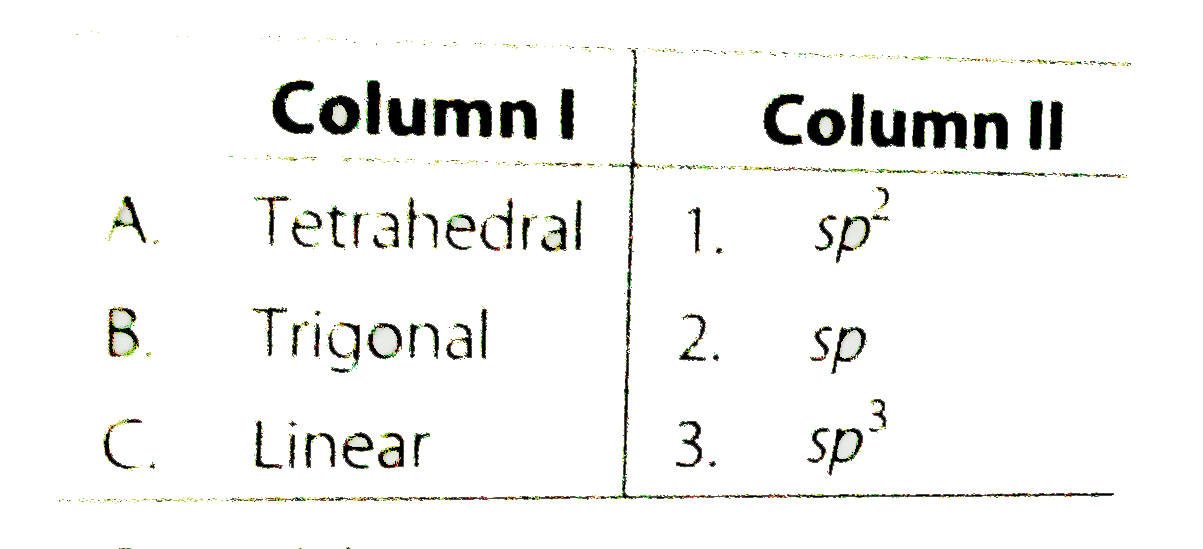Match the terms mentioned in Column I with terms in Column II.
Column IColumn II(a)carbocation(i)Cyclohexane and hex-1-ene(b)Nucleophile(ii)Conjugation of electrons of C - H σ bond with empty p-orbital present at adjacent positively charged carbon (c)Hyperconjugation(iii)Sp2 hybridised carbon with empty p-orbital(d)Isomers(iv)Ethyne(e)sp hybridisation(v)Species that can receive a pair of electrons(f)Electrophile(vi)Species that can supply a pair of electrons
The correct Answer is:(a)-(iii); (b)-(vi); (c)-(ii); (d)-(i); (e)-(iv); (f)-(v)
Topper's Solved these Questions
- ORGANIC CHEMISTRY - SOME BASIC PRINCIPLES & TECHNIOUESBOOK - DINESH PUBLICATIONCHAPTER - ORGANIC CHEMISTRY - SOME BASIC PRINCIPLES & TECHNIOUESEXERCISE - Assertion-Reason
17 Videos
- ORGANIC CHEMISTRY - SOME BASIC PRINCIPLES & TECHNIOUESBOOK - DINESH PUBLICATIONCHAPTER - ORGANIC CHEMISTRY - SOME BASIC PRINCIPLES & TECHNIOUESEXERCISE - MCQS
12 Videos
- ORGANIC CHEMISTRY - SOME BASIC PRINCIPLES & TECHNIOUESBOOK - DINESH PUBLICATIONCHAPTER - ORGANIC CHEMISTRY - SOME BASIC PRINCIPLES & TECHNIOUESEXERCISE - NCERT Exemplar Problems
22 Videos
- NUCLEAR AND RADIO CHEMISTRYBOOK - DINESH PUBLICATIONCHAPTER - NUCLEAR AND RADIO CHEMISTRYEXERCISE - Evaluate Yourself
45 Videos
- P BLOCK ELEMENTS (GROUP 13 AND 14 )BOOK - DINESH PUBLICATIONCHAPTER - P BLOCK ELEMENTS (GROUP 13 AND 14 )EXERCISE - Straight obj.
17 Videos
Similar Questions
Match the terms in column I with those in column II:
Column IColumn II(i)Trypsin(a)Liver(ii)Amylase(b)Gastric glands(iii)Bile(c)Pancreas(iv)Pepsin(d)Saliva
View SolutionMatch the items given in Column 1 with examples give in Column II.
Column IColumn II(a)Hydrogen bond(i)C(b)Resonance(ii)LiF(c)Ionic solid(iii)H2(d)Covalent solid(iv)HF(v)O3
View SolutionMatch the items given in Column 1 with examples give in Column II.
Column IColumn II(a)Hydrogen bond(i)C(b)Resonance(ii)LiF(c)Ionic solid(iii)H2(d)Covalent solid(iv)HF(v)O3
View SolutionMatch the items given in Column I with examples given in Column II.

View SolutionMatch the shape of molecules in Column I with the type of hybridisation in Column II.

View SolutionMatch the species in Column I with the geometry/shape in Column II.
Column IColumn II(i)PCl5(a)Tetrahedral(ii)ClF3(b)Pyramidal(iii)NH+4(c)Bent T shape(iv)H3O+(d)Trigonal bipyramid
View SolutionMatch the terms mentioned in the column I with the terms in column II — Column I- (a)Hyperconjugation, (b)Isomers, (c)Nucleophile, (d)Electrophile, Column II- (i)Cyclohexane and 1−haxe≠, (ii)σ−π conjugation, (iii)species that can receive a pair of electron, (iv)species that can supply a pair of electrons
View SolutionMatch the shape of molecules in Column 1 with the type of hybridisation in Column II.
Column IColumn II(a)Tetrahedral(i)sp2(b)Trigonal(ii)sp(c)Linear(iii)sp3(d)Trigonal bipyramidal(iv)sp3d
View SolutionMatch the shape of molecules in Column 1 with the type of hybridisation in Column II.
Column IColumn II(a)Tetrahedral(i)sp2(b)Trigonal(ii)sp(c)Linear(iii)sp3(d)Trigonal bipyramidal(iv)sp3d
View SolutionMatch the species in Column I with the bond order in Column II
Column I Column II (i)NO (a)1.5(ii)CO (b)2.0(iii)O−2 (c)2.5(iv)O2 (d)3.0
View Solution
